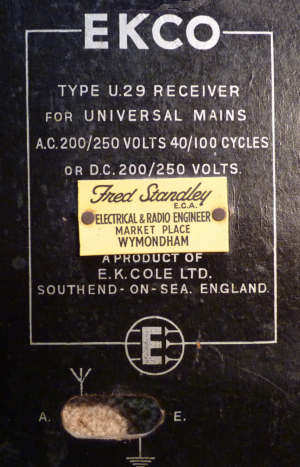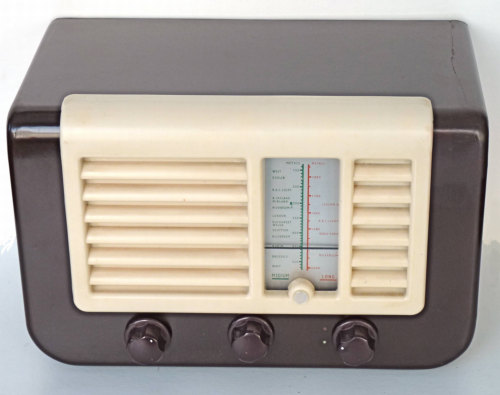
Serial number 00840

This valve radio was in a poor condition when received, the case was broken and the greater part of the right handside was absent. Short of making a new case for it I wondered whether it was worth doing anything with at all except for salvaging the valves and one or two components. Michael Marwood, who gave me the radio, subsequently gave me the larger of the missing pieces which can be seen here in position prior to fixing with 'superglue'. A piece of thin aluminium was attached to the inside of the case with double sided adhesive tape and the missing portion was filled with a two part wood filler and smoothed and shaped when set. The filler was white so the repair was coated with acrylic paint mixed to be a near match to the brown colour of the original moulding. The finished result,though still not perfect is shown above.
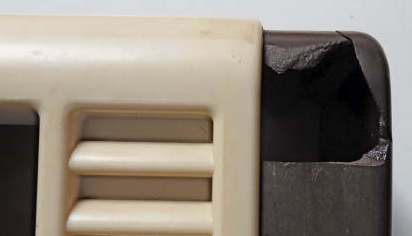
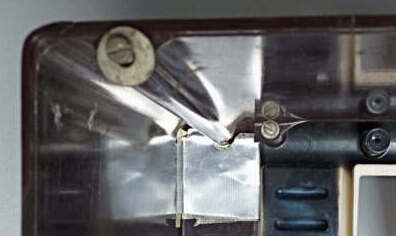
Having repaired the case I then turned my attention to the radio itself. Apart from the dirt and dust on the top of the chassis it was apparent that the dial cord had broken, several wax covered capacitors had been very hot at at some time in the past and the wave change switch needed attention to limit the rotation of the wafer. It was also noted that some of the rubber insulation on the wiring had become very brittle and in a few places had come away.
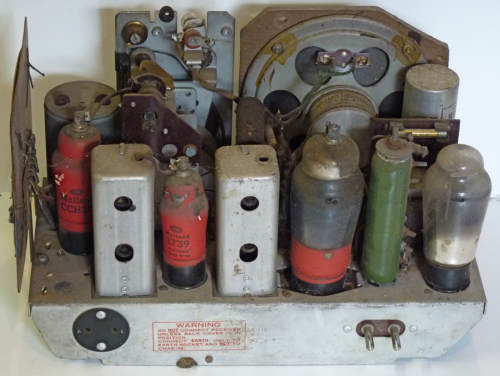
This is a view of the chassis as received. The frame aerial mounted on a thin sheet of Bakelite is mounted on the left of the chassis. Power is supplied to the radio by a female plug which would mate up with the two pins protruding from the right hand side.
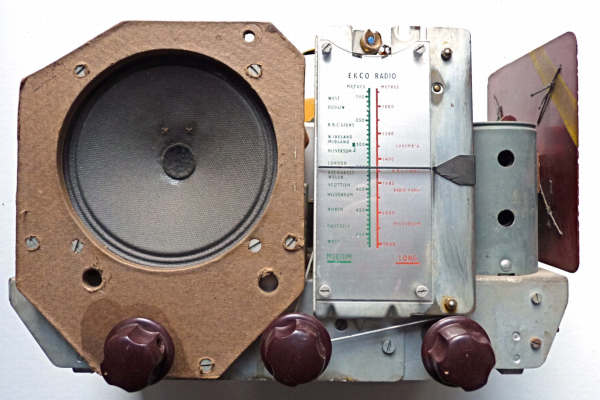
This is a view of front of the chassis showing the dial mechanism with new drive cord. The whole scale and drive assembly has to be removed to replace the cord. After removing the dial lamp holder, two set screws on the tuning capacitor shaft have to be slackened, three screws at the rear and two at the front then have to be removed to do this. One of the the two screws at the front can be seen below the scale on the view above and two of the three rear screws can be seen either side of the dial lamp on the view below. Before re-assembling I took the opportunity to carefully clean the scale and lubricate the pulleys.
The valves were then removed and cleaned and the bulk of the dust removed from the chassis and the holders were given a blast of switch cleaner before they were put back.
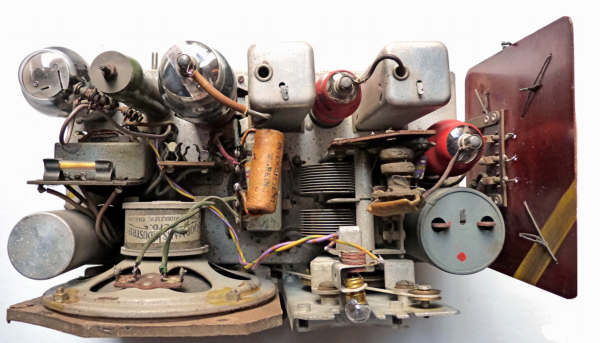
When I energised the set nothing happened, complete silence and no glowing valve heaters or dial lamp. I checked the fuses the dropper resistor and the in-line RF filter chokes, everything is in order, but I find that the double pole switch on the rear of the volume control seems to be stuck in the open position. When this is taken apart two pieces of broken spring fall out. I have a 1 megohm log potentiometer with a single pole switch but as this is a universal set a double pole switch is essential. With some ingenuity I managed to fit the 1 megohm track into the housing of a similarly sized potentiometer with a double pole switch. As this was a smaller unit than the one originally fitted I had to remove the locating pip and solder a replacement on the case to match up with the original hole in the chassis. I also soldered a small piece of bent copper to the wave change switch to prevent movement of the wafer beyond the stops.
With the valves back in place I again switched it on and as before nothing happened so I checked the one thing that I had not done previously, yes, an open circuit heater and heater cathode short on the CCH35 frequency changer. Rummaging through my box of octal valves I found a very scruffy replacement. Things did not seem to be going well so I decided to to test each of the valves in my AVO valve tester. This showed that they were all functioning, though not as well as the makers intended. With the valves yet again back in place and switching on once more, smoke emanated from the upturned chassis. These wax capacitors had to go! One by one I disconnected one side of every capacitor and tested them with my megger, and I found that even the ones that had not been dripping wax were showing resistance of less than 500k. Reluctantly I decided that wholesale replacement seemed to be in order except for the cathode bypass electrolytic on the output valve and the tone corrector capacitor across the primary of the output transformer which tested OK.
Now feeling optimistic, yet cautious, I fed the set via a variable transformer and gradually increased the voltage. The dial lamp glowed and for the first time noise came from the speaker and when an aerial was plugged in I found that it worked well on both wavebands and that I had replaced the pointer on the dial cord in the correct position. Whilst the set was left working merrily on the bench top I set about making a lead with a female two pin plug and drilling out and tapping the fixing holes for the back cover for 4BA screws as the originals must have been of some odd size.
The set was to test me further for when I had it all assembled in its now shiny case complete with knobs and back, it steadfastly remained silent. I found that there was no signal getting to the grid of the output valve and this was because the rubber insulation in the screened lead to the top cap had perished and the grid was effectively earthed. This and the screened lead from the preceding stage was replaced, but in doing so I had inadvertently disturbed the insulation on the wiring to the heater ballast resistor and it had decided to touch the chassis, blow one of the fuses and the dial lamp when next I switched it on. After replacing this, the wires to the dial lamp the fuse and 6 volt dial lamp the radio functioned properly both outside and inside its case.
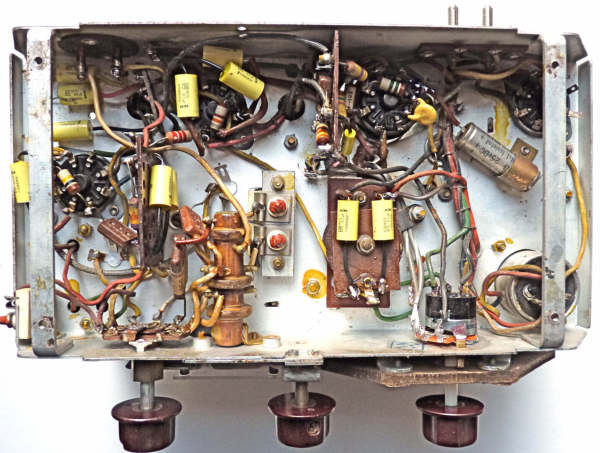
Wise after the event, I find from a search on the internet that the problems I found on this model are not unique. Others have discovered the problems with brittle insulation, failed wax capacitors, broken dial cord,faulty volume control switch and long warm up time. My set takes a full 60 seconds from switch on for sound to come from the speaker.
I have also discovered that the firm which supplied the radio back in 1946 still exists: at 31-33 Market Street, Wymondham, Norfolk.
The firm was established in 1928 by Mr Fred Standley. He learnt his trade in the Royal Navy, and opened a shop on the Market Place in Wymondham selling Radios and all types of Electrical Appliances, Cookers, Boilers etc. He also carried out all sorts of electrical work for local farms and councils. In the late 40's often wiring complete villages and employing up to eleven electricians. In the 50's the firm moved into Television Sales and Rental, installing Aerials etc. The firm relocated to the present address in Market Street in the mid 60's. In the early 1990's They joined the Euronics buying group and have never looked back. Four generations of the family have run the company. Fred Standley's son David continued the business until his retirement and David's son, Chris and now his nephew run it today.
This is an article I submitted to the BVWS Bulletin
